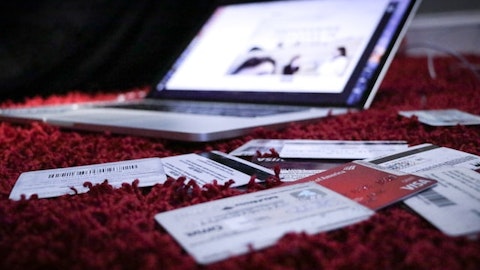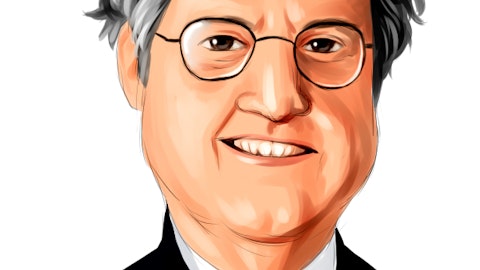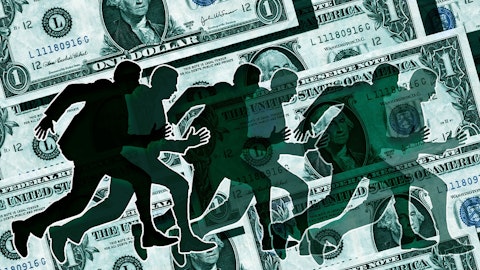Advisory is up far more than that. Those two businesses this quarter did over $10 million in EBITDA. So we underwrite that to $8 million to $10 million in EBITDA per quarter. So you’re at about $30 million. Telecoms, we were underwriting that to closer to $70 million, $80 million a quarter. I think it’s in and around $15 million to $17.5 per million quarter, the telecom assets. Wealth, we underwrite to about $4 million per quarter. Brands, including BB, $12 million per quarter, Interest income in and around $25 million per quarter, $25 million to $30 million per quarter, and Targus, $10 million per quarter. So Targus right now is — last quarter was flat. It’s going to be EBITDA positive this quarter, and we are starting to see the PC market come back for many, many years.
That business generated at least $40 million in EBITDA per quarter. So we’re not going to — we recognize right now that, that business is up but in our long-term model, we underwrite that. So if you add all that up, it comes out to somewhere and then take $10 million from Core it comes out to somewhere in and around $85 million, $90 million. And then there’s — we think those are the conservative views of each of those businesses.
Mike Frank: And then, Phil, do you want to comment on the interest expense going forward and any other corporate overhead that might be included in those recurring businesses?
Phillip Ahn: Well, I can just comment on the go-forward interest expense. We’re roughly run rating at $42 million a quarter in interest expense that when we netted against some of our investments and the net interest income that we’re receiving, the net of that is in the low 20s. And the — when Bryant was just talking about the operating business that is inclusive of allocations for corporate.
Bryant Riley: So the quick math, quick math is if you take 90 and we have D&A of 12 — excuse me, we have interest of, call it, 40. It depends whether we’re going to pay taxes or not. The dividend — there’s no CapEx in this business, very little CapEx. And you always have a minimum amount of taxes, but that’s kind of the math.
Operator: Our next question comes from Brett at Nokomis Capital.
Brett Hendrickson: Bryant, could you just remind us which brands were the — where essentially your royalty income goes into dividend? And if there’s anything else that was added into that line-item year-over-year.
Bryant Riley: Yes. Phil, do you have the breakdown of each of the brands roughly? I mean do you have that number handy.
Phillip Ahn: I’m sorry, actually, I don’t have that, but I can follow up on that with you, Brett.
Brett Hendrickson: Okay.
Bryant Riley: Yes. Brett, the number you’re solving, the Brands business had a really strong quarter. Hold on will just give you a little bit to have it here. Just give me one second. But the Brands business had a really strong quarter. So six brands for the quarter was in and around 3-ish and change million. Hurley Justice was in and around $9 million, that’s $9.5 million, that’s higher than typical. Scotch & Soda, we had a little bump from Scotch & Soda because they have done a really good job of kind of getting to a spot of liquidating the assets before it’s just a regular brand. So we picked up a couple of million there. So that’s probably the biggest difference you’re seeing is the Scotch & Soda.
Brett Hendrickson: Got it. Because I can’t remember the timing. Scotch & Soda was not in Q3 a year ago?
Bryant Riley: No. It was not.
Brett Hendrickson: Okay. So when I think of that — I think it went from $9.2 million to $12.9 million of dividend income, I should think about a moderate amount of same-store growth, probably mostly limited to which we’re seeing in, I guess, a bigger presence in Walmart and then adding Scotch & Soda get to that growth.
Bryant Riley: Yes.
Operator: This concludes today’s Q&A. I’d like to turn the call back to Mr. Riley for his closing remarks.
A – Bryant Riley: Thanks, operator. I want to actually answer some questions that I don’t think were asked, and I think there’s noise out there, so I want to address it and be crystal clear. We would have bought all of Franchise Group. We are a huge fan of that business, and it’s a really simple analysis. They have a great steady EBITDA in Vitamin Shoppes. Pet Supplies Plus, which is bought for $900 million is going to get to $140 million in the next couple of years. American Freight is an unbelievable business that faces the same challenges at Targus. That’s a business that was doing $110 million in 2021 and went down along with Badcock. That was our opportunity. And we would buy that over and over again. We were a founder in that business.
We have been a great — we’ve got a great partnership with Brian. We have a great partnership with other management teams. We’ve helped fund Badcock. We sold the real estate. We made 27% IRR on our receivables. We made the first batch, we made over 40% on the second batch. We have $50 million exposure there now, which is money good. And we, over time, determine that the better path was to allow shareholders that were involved in Franchise Group, many of which rolled as well as management, many of which purchased in the deal to participate. So there should be no confusion where that is. And I know that today, a statement came out from Brian denying any involvement and what happened with Prophecy, and that’s good enough for me. So I’m — I don’t — I want to just be crystal clear.





